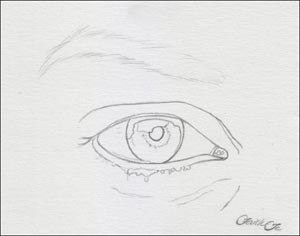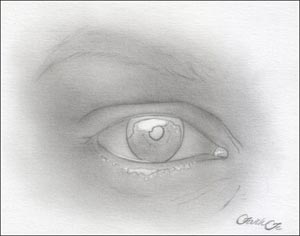Here is the first tutorial from Art Studio — a female eye. My method in graphite pencil drawing aims to render subjects as realistically as I can. The following is a step-by-step demonstration of how I draw eyes. While I very much hope that it helps you in drawing realistic eyes, do experiment and develop your own way of drawing. I myself sometimes do not follow some of the steps exactly as I like to experiment and try to find better ways of achieving a specific texture or effect. Before I begin, many thanks to Toni-Marie Hudson for the use of her picture. Toni-Marie does animal paintings in mixed media. Visit her web site to view her extremely realistic paintings.
Step One

The outline on Canson Grain. Since the outline was very light and will likely be smudged off when I start rendering or shading, I have carefully and lightly retraced the lines with a soft pencil. In this case, a Faber-Castell 0.5 mm 2B mechanical pencil.
 Step Two
Step Two
Using a soft brush dipped in small amounts of graphite powder, I cover the outline with two or three layers of tone. Any brush can be used as long as it produces a very smooth effect and fills in the tooth of the paper. I try to avoid getting tone on the highlight of the iris. If I do get any graphite there, I tap the area with a clean kneaded eraser.
Step Three
Using a smaller version of the brush I used in
the previous step, I begin forming the shapes
of the eye by defining the darker areas..
Step Four
With a kneaded eraser, I cleaned up the highlights.
Step Five
I used a Dong-A 0.5 mm 2B mechanical pencil to draw the darkest areas like the pupil, shadow on the upper part of the iris and the crease of the upper eyelid.
Step Six
Concentrating on the iris for now, I use a hard pencil (5H Staedtler) and fairly hard pressure to draw spokes originating from the pupil. This will keep the paper from absorbing a lot of graphite in the next
stage.
 Step Seven
Step Seven
Having used a 5H on the previous stage, I can now draw darker shades on the iris using a dark pencil (2B mechanical pencil). The reason why I use 2B is because it spreads more easily. The 5H is also to keep the tones very smooth when darker tones are added.
Step Eight
I further worked on the iris erasing and adding graphite as much as needed to create varied tones. Moving on to the white of the eye, it was also covered with a layer of 5H to create a smooth effect. Then I used a 2B mechanical pencil on the shadow areas to form the eyeball.
 Step Nine
Step Nine
Here I began working on the skin. Using a 0.5 mm HB mechanical pencil and a light circular motion, I added tones to the upper eyelid and the surrounding skin - starting first on an area which will receive more graphite (in this case, the skin around the crease) and moving towards lighte areas. I used a shop towel and a brush to smoothen out rough spots.
Step Ten
Continued with the lower part of the skin.
 Step Eleven
Step Eleven
Still continuing with the HB mechanical pencil. I’ve now added shadows to the skin. The 5H Staedtler pencil was also used on the thickness of the lower eyelid. 2B mechanical pencil was used for its darker areas.
 Step Twelve
Step Twelve
To create the wrinkles on the skin, I lightly drew lines with the HB mechanical pencil and then used a kneaded eraser to create fine highlights beside each line. A paper stump and a brush were used to
soften and blend the lines. The same method used on the white of the eye was also used on the tear duct. The HB was used for the eyebrow — starting with the root of each hair and lessening pressure towards the tip.
 Step Thirteen
Step Thirteen
I always try to keep from drawing the eyelashes until the skin underneath is finished. Since the upper eyelashes will be darker than the lower eyelashes or the eyebrow, I used a Dong-A 2B mechanical pencil which is much darker than a Faber-Castell of the same grade. Again, following the direction of growth and starting from the root, lessening pressure as I come to the tip. Reflections of the eyelashes were also drawn on the highlight of the iris.

Step Fourteen
The lower eyelashes were drawn with the Faber-Castell 2B mechanical pencil.
 Step Fifteen
Step Fifteen
The final eye. Finishing touches were made and some of the highlights on the lower eyelid were dulled a little. I hope you find these steps and images informative and helpful.
Happy drawing,
Visit Faith Te's Website
Tutorial is copyright of Faith Te





No comments:
Post a Comment